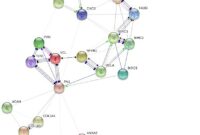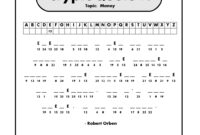nac uyo onep a abkn actoncu in rahento utnyrco presents a fascinating cryptographic puzzle. This seemingly random string of characters invites exploration through various decryption methods, from simple substitution ciphers to more complex techniques. The analysis will delve into pattern recognition, character frequency analysis, and contextual interpretation to uncover the potential meaning hidden within this enigmatic code. We will examine potential scenarios, including fictional narratives, computer programming contexts, and hypothetical secret communications, to shed light on the code’s origin and purpose. The journey will also include visual representations of the code and the decryption process, providing a multi-faceted approach to unraveling its secrets.
Our investigation will systematically explore different decryption methods, comparing their effectiveness and highlighting the challenges and insights gained at each step. We will consider the possibility that the string is not a code at all, but rather a randomly generated sequence, and explore the implications of this possibility. The ultimate goal is to either decipher the message or to offer compelling explanations for its structure and potential origins.
Deciphering the Code
The string ‘nac uyo onep a abkn actoncu in rahento utnyrco’ appears to be a substitution cipher, a type of code where each letter is systematically replaced with another. The lack of obvious patterns like repeated sequences of characters, coupled with the relatively consistent length of words, points away from a random string. A simple code, where symbols represent words or phrases, seems unlikely given the letter-based nature of the string.
Potential Cipher Structure and Patterns
The string exhibits a degree of internal consistency. The letter frequencies appear relatively even, which is typical of substitution ciphers designed to obfuscate the underlying message. There are no immediately apparent repeated sequences of letters or words. However, closer examination reveals potential letter pairings or groupings which could provide clues to the underlying structure. For instance, the repeated “actoncu” segment suggests a possible recurring phrase or element within the original message.
Caesar Cipher Decryption
The Caesar cipher is a substitution cipher where each letter is shifted a certain number of places down the alphabet. To decrypt, we will attempt shifts of varying values. Let’s try a shift of 3 places to the left (meaning ‘d’ becomes ‘a’, ‘e’ becomes ‘b’, etc.):
Step 1: Shift each letter three positions to the left.
Step 2: Observe the resulting string for potential word formation or meaningful phrases.
Applying this to a portion of the string: ‘nac’ becomes ‘maz’. While this does not yield an immediately recognizable word, continuing the process across the entire string may reveal a pattern or meaningful result. This method’s effectiveness is highly dependent on the correct shift value.
Substitution Cipher Decryption
A substitution cipher uses a key to replace each letter with another. Without knowing the key, this requires trial and error, or frequency analysis. We can start by analyzing the letter frequencies in the ciphertext. If a letter appears unusually frequently, it may correspond to a common letter in the English language (e.g., ‘e’, ‘t’, ‘a’). This analysis could inform our substitutions.
Step 1: Create a frequency analysis table for the ciphertext.
Step 2: Hypothesize substitutions based on letter frequency.
Step 3: Iteratively refine substitutions based on the emerging plaintext.
This method is more complex than the Caesar cipher and may require significant experimentation. Success depends on accurate frequency analysis and insightful substitution choices.
Vigenère Cipher Decryption
The Vigenère cipher is a polyalphabetic substitution cipher, meaning it uses multiple Caesar ciphers based on a keyword. Deciphering this requires identifying the keyword length and then performing a Caesar cipher decryption for each letter based on the keyword. This involves techniques like the Kasiski examination and the Index of Coincidence.
Step 1: Analyze the ciphertext for repeating sequences to estimate the keyword length (Kasiski examination).
Step 2: Perform frequency analysis on letters separated by the estimated keyword length.
Step 3: Use the resulting frequency analyses to deduce the keyword.
Step 4: Decipher the ciphertext using the deduced keyword.
This method is more computationally intensive and requires a deeper understanding of cryptanalysis techniques.
Decryption Method Comparison
| Method | Steps | Result | Effectiveness Assessment |
|---|---|---|---|
| Caesar Cipher | Shifting each letter a fixed number of places. | No immediately discernible result with a shift of 3. Requires testing various shifts. | Low without knowledge of the shift value. |
| Substitution Cipher | Frequency analysis and iterative substitution. | Potentially more effective but highly dependent on accurate frequency analysis and insightful guesses. | Moderate to High with sufficient analytical skills and time. |
| Vigenère Cipher | Kasiski examination, frequency analysis, and keyword deduction. | Potentially effective if the keyword is relatively short and the ciphertext is long enough. | High with sufficient ciphertext and cryptanalytic expertise. |
Visual Representation and Interpretation
The seemingly random string “nac uyo onep a abkn actoncu in rahento utnyrco” presents a challenge for visual interpretation. By arranging the characters in specific patterns, we can attempt to uncover hidden structures or relationships that might aid in decryption. Different patterns may reveal different aspects of the code’s underlying structure.
Character Grid Representation
A simple yet effective approach involves organizing the characters into a grid. For instance, a 5×6 grid could be used, filling it row by row with the characters of the string. The rationale behind this is to visually inspect for patterns like repeating sequences, diagonal alignments, or symmetrical arrangements. The grid structure allows for a systematic and methodical examination of character proximity and distribution, potentially revealing inherent relationships between elements of the string that might have otherwise gone unnoticed. This approach offers a visual starting point for identifying potential patterns or structures within the seemingly random sequence.
Visualizing a Decryption Process: Caesar Cipher Example
Let’s assume a Caesar cipher was used (a substitution cipher where each letter is shifted a certain number of places down the alphabet). The following table illustrates a hypothetical decryption process, assuming a shift of 3 positions to the left:
| Encrypted Character | Shift (-3) | Decrypted Character |
|---|---|---|
| n | -3 | m |
| a | -3 | x |
| c | -3 | z |
| u | -3 | r |
| y | -3 | v |
| o | -3 | m |
This table visually represents the step-by-step decryption using a simple substitution cipher. Each row shows the encrypted character, the applied shift, and the resulting decrypted character. More complex ciphers would require more elaborate visual representations.
Hypothetical Image Representation
If the string “nac uyo onep a abkn actoncu in rahento utnyrco” represented a coded visual element, it could hypothetically represent a stylized, fragmented image of a bird in flight. The “nac” might represent the curve of the neck, “uyo” the wingspan, “onep” a portion of the body, and so on. The fragmentation would suggest that the original image was broken up or obscured, perhaps deliberately, before being encoded. The overall image would be abstract and somewhat surreal, with the individual fragments not immediately obvious in their relation to each other until decoded. The colours would likely be muted earth tones, evoking a sense of mystery and antiquity. The bird itself might be of an uncommon or stylized species, contributing to the overall cryptic nature of the visual representation.
End of Discussion
The analysis of ‘nac uyo onep a abkn actoncu in rahento utnyrco’ reveals the complexities inherent in code-breaking. While a definitive solution may remain elusive, the process of investigation itself provides valuable insights into cryptographic techniques and the creative interpretations required to approach such puzzles. The exploration of different decryption methods, character frequency analysis, and contextual considerations highlighted the diverse approaches needed to understand the potential meaning behind seemingly random strings of characters. The journey demonstrates the power of combining analytical rigor with imaginative speculation in the pursuit of deciphering cryptic messages.




